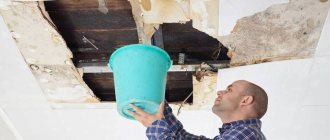It may be necessary to draw up an apartment inspection report both in case of violation of the rights of the homeowner and when concluding transactions. Such a document will record the condition of the apartment and the property in it as of a certain date. For example, damage caused to real estate owned by right of ownership (as well as under a lease agreement and other cases of transfer of rights of use and ownership) must be compensated by the culprit. And the degree, size, and cause of damage are established precisely by the act.
If you intend to go to court with a claim for compensation for damage from an apartment flood, etc., a correctly drawn up apartment inspection report will become the main evidence in a civil case. And if the culprit intends to voluntarily correct the harm caused, it will become insurance against dishonest behavior and will allow you to successfully defend your interests in court.
The document can also be drawn up in other cases: when purchasing an apartment in a new building, concluding a purchase and sale agreement. In such cases it can also be called a transfer and acceptance certificate, or a list of detected defects. The main rule is that all shortcomings and claims against the developer must be reflected in the document. If an authorized person refuses to draw up such an act, you yourself can draw up your own document and an act of refusal to sign, based on the example below.
:
Form
To draw up such an act there is no need to use a unified form. The document is drawn up in a free style. The main thing you need to pay attention to here is the indication of all important information. This is a detailed description of the apartment and the parties who are parties to the transaction. As a rule, the parties choose the most suitable form in advance by mutual agreement.
When and why do you need an apartment inspection report?
Using the deed, the parties document the condition of the property. Conventionally, the inspection report can be divided into two types:
- Required . In this case, there is no way to do without an inspection. As a rule, such situations arise during investigations, investigative or judicial audits.
- Optional . When citizens or organizations transfer an apartment from hand to hand, for example, when selling, renting or donating, drawing up a deed is desirable. But it cannot be called mandatory, because the law allows you to do without this document.
Although practice shows that recently even individuals are trying to properly prepare such a document. After all, it is this act that will be considered first if any disagreements arise between the parties. For example, if we are talking about selling an apartment, its inspection is in the interests of all interested parties:
- The seller of the apartment needs an inspection report so that he has documentary evidence of this fact. Also, taking into account the collected acts, the seller may decide to change the terms of sale. If the buyer agrees to sign the inspection report, this will indicate that he is completely satisfied with the condition of the home. Accordingly, if after the transaction the buyer wishes to make any claims, this act will be a weighty argument in favor of the seller.
- Realtor, if the seller resorted to his services. Based on this document, he reports to the seller, since the time and date of the inspection must be indicated here. Information about the buyer is also noted. With the help of this act, the realtor will be able to prove that he was the one who found the buyers.
- The buyer practically does not need an inspection certificate. Although you may encounter a situation where law enforcement agencies have questions. For example, if this apartment was robbed, the buyer will have documentary evidence of the reason why he was here.
- The tenant will need this document when he returns the apartment to the owner. The act will confirm that the technical condition of the premises has not changed.
- To the landlord when he rents out the property. After a certain period of time, he will be able to check whether the condition of the apartment has worsened. If it has changed for the worse, the owner may demand compensation from the tenant for damages.
Time to visit: when is the best time to inspect the apartment?
Residential premises should be inspected only during daylight hours . Thanks to this you will be able to:
- determine whether there is enough light in the apartment;
- see all existing imperfections and defects (scratches, cracks, leaks, chips, etc.).
You should also insist that the inspection be individually and not in a group with other potential Buyers. This way you will be able to explore the entire apartment without haste and form the most unbiased opinion about the property.
Premises inspection procedure
There are no regulated actions regarding apartment inspection. Usually this procedure is individual for each case. Naturally, one person cannot conduct an inspection. For this purpose, a special commission is assembled, which includes representatives of all interested parties.
Once inside the premises, the commission checks its technical condition, communication networks, and electrical equipment. In addition, special attention is paid to fire safety, which must be observed in this room. Under certain circumstances, environmental safety is also of great importance. Here the cleanliness of the apartment is checked, the absence of fungus on the walls and various parasites.
( Video : “Act of acceptance and transfer of apartment”)
The inspection commission inspects room by room, recording any comments using the appropriate report. If there are no comments, and the general condition of the apartment is satisfactory, this should be written about in the document.
Rules for drawing up an act
As you might guess, one person cannot conduct a home inspection. Indeed, in such a situation there is a high probability of making mistakes. The inspection commission must consist of at least two specialists. Typically, this procedure is entrusted to representatives of government departments and supervisory authorities. The legislation does not prohibit the involvement of additional experts in this process. These could be technicians, electricians, engineers. Thanks to this, we can say that the inspection of the premises and the inspectors’ conclusions will be as objective as possible.
You can enter information into a document on a computer or by hand. Often an apartment inspection is carried out so that the commission can determine what damage has been caused to the property. This fact should be stated in the act. In addition to this, it is necessary to note the reason why this damage was caused. If the alleged culprits are known, information about them should also be displayed in the document.
There are situations when some additional annexes are drawn up to the act. If there are any, this should be mentioned in the act itself. For example, if the inspection of the apartment was carried out using a camera, the photographs become an appendix to the report.
Content
- A complete list of detected defects in the apartment with links to SNiPs.
- Time frame for eliminating identified deficiencies.
- List of persons responsible for eliminating deficiencies.
SNIPs that must be referenced
All deficiencies found in the apartment must be confirmed, otherwise the developer has the right not to take them into account and, accordingly, not to correct them. The developer will not accept unfounded claims , so you should rely on SNIPs and other acts of state standardization.
A full list of SNIP requirements for the inspection sheet can be found here.
General requirements for the content of the apartment inspection report in 2021
The deed is usually drawn up in the form of a descriptive document. Although, for greater convenience, some format the document in table form. This is especially convenient when a large amount of information is entered into the act. As for the volume, it all depends on the complexity of the apartment. The larger it is, the more information will be available during inspection. The scope of the act is also influenced by the goals pursued by this inspection. The larger they are, the broader the document becomes.
Important information that must be contained in the document includes information about the real estate that was subject to inspection. The responsible persons who worked directly at the site are also indicated here. Naturally, the commission must draw conclusions. If there are any comments, they are recorded in the act. If there are none, it should be written that there are no comments.
The document must have several copies. Each interested party must receive one copy. All of them have the same legal force; accordingly, autographs of representatives of each party must be affixed here. If an organization that uses a seal in its activities takes part in a transaction, it puts the stamp on the document. It must be remembered that a correctly drawn up act will become powerful evidence in court proceedings.
Instructions for filling out the act
Despite the fact that the document is drawn up in free form, there are general rules for office work. Usually there are no difficulties with filling out the act. The document is filled out step by step:
- You need to start by filling out the “cap”. The name of the document, city and date of compilation are indicated here.
- The composition of the inspection team is indicated. This is not only the name of each specialist. It is necessary to indicate what organization he represents and what position he holds.
- The fact of inspection of the premises is confirmed below. You must indicate the exact address where it is located. If the apartment is on the balance sheet of some company, this should also be mentioned.
- Next, members of the review team must draw conclusions. If no defects are found, it is necessary to indicate that the condition of the premises is satisfactory.
- It would be useful to point out that there are no comments on the electrical equipment and the general condition of the apartment.
- The final stage of filling out the document is affixing autographs of all responsible persons. Moreover, the signatures must have a transcript.
It is worth noting that this is only an approximate example of filling out the document. At the discretion of the responsible persons, you can specify additional items in which more detailed information will be displayed. For example, you can imagine a situation where members of the inspection team discovered any problems or malfunctions. In such a situation, they must be written down in great detail. Here you need to understand that even the smallest complaints must be described. After all, they are the ones who can cause disagreements between the parties. For example, when renting out an apartment, the commission will not take into account torn linoleum. If the tenant does not notice such an oversight, it will be considered that he received the apartment in perfect condition. Upon its return, the owner may demand compensation for damage to which, in fact, the tenant has nothing to do. Therefore, even minor details must be displayed in the document.
Basic rules for drawing up an act
There is no unified, single template for drawing up this document, so you can write it in free form. You can fill out the act by hand or print it on a computer. The main thing is that it contains information about the object being inspected, information about the members of the inspection commission, an accurate description of their conclusions, as well as comments and shortcomings identified during the procedure. If an inspection of the premises is carried out to establish the fact of damage, then this must also be noted, indicating the cause, the alleged culprit, as well as the identified cause-and-effect relationships.
The document can be created in a descriptive form, or it can be compiled in the form of a table.
The more complex the structure of the inspected premises is, the more ambitious the objectives of the inspection are, the more voluminous and broad the act becomes.
Sometimes separate annexes are attached to the act - they must also be indicated in the main document.
Quite often, during inspections, the object is photographed, and then the photographs are also included in the act as attachments. If, during the inspection of the premises, electrical equipment, ventilation, heating and water supply systems are checked, the report must certify that their condition complies with established norms and standards.
The act is drawn up in several copies - one for each of the interested parties. Each copy of the act must be certified by the original signatures of the members of the commission conducting the inspection, and also certified by the seals of the relevant organizations. A correctly drawn up act acquires legal force and can serve as evidence in court.
How to inspect the area, local area and entrance
Before visiting the selected apartment, the Buyer is recommended to walk around the surrounding area . Note:
- on the condition of roads and sidewalks;
- for the total number of parking spaces in yards;
- on the greenery of the surrounding area;
- for the presence/absence of grocery stores, pharmacies, etc.
Check if there are enough public transport stops around. At the stop, you can turn to one of the local residents and ask him whether buses, trolleybuses, and trams run here often. Think about how you will get to work, school, or take your children to classes (how long it will take and whether it will be convenient for you to travel the planned route every day).
If at the first stage you are satisfied with everything, the inspection will continue further - already in the courtyard of the house . The presence of leisure facilities (children's and sports grounds, recreation areas) plays an important role here. Assess the external condition of the house. If the area around the house is fenced, it is safer and preferable for you as a future occupant.
Consider handicapped mobility structures if this is of utmost importance to you or your family. Also evaluate the surrounding population and think about whether you will be comfortable living next to these people.
If the overall impression is positive, go further - to the entrance of the house . Here you will need to pay attention to:
- the degree of cleanliness of the entrance (how well the floors are swept or washed, whether there is graffiti on the walls, whether cigarette butts and other waste materials are scattered on the stairs);
- illumination of the entrance (are there light bulbs screwed in everywhere);
- temperature and humidity of the entrance (is it too damp, hot, cold, unpleasant);
- smell in the entrance;
- the integrity of walls, floors, ceilings (if there are noticeable cracks or stains somewhere, this may indicate the dilapidation of the entire building);
- presence/absence of garbage chutes, their general appearance and condition;
- serviceability and cleanliness of elevators.






